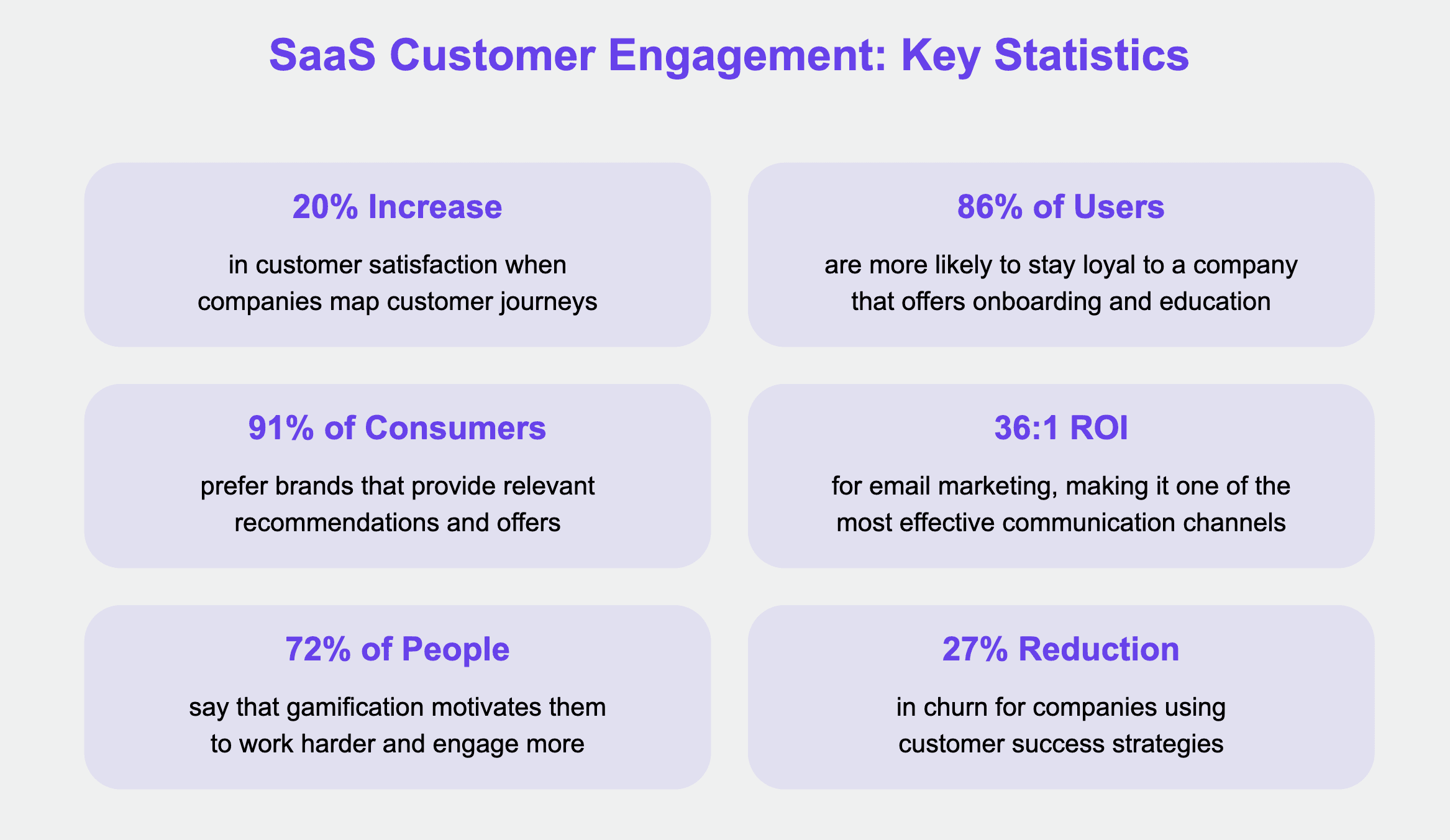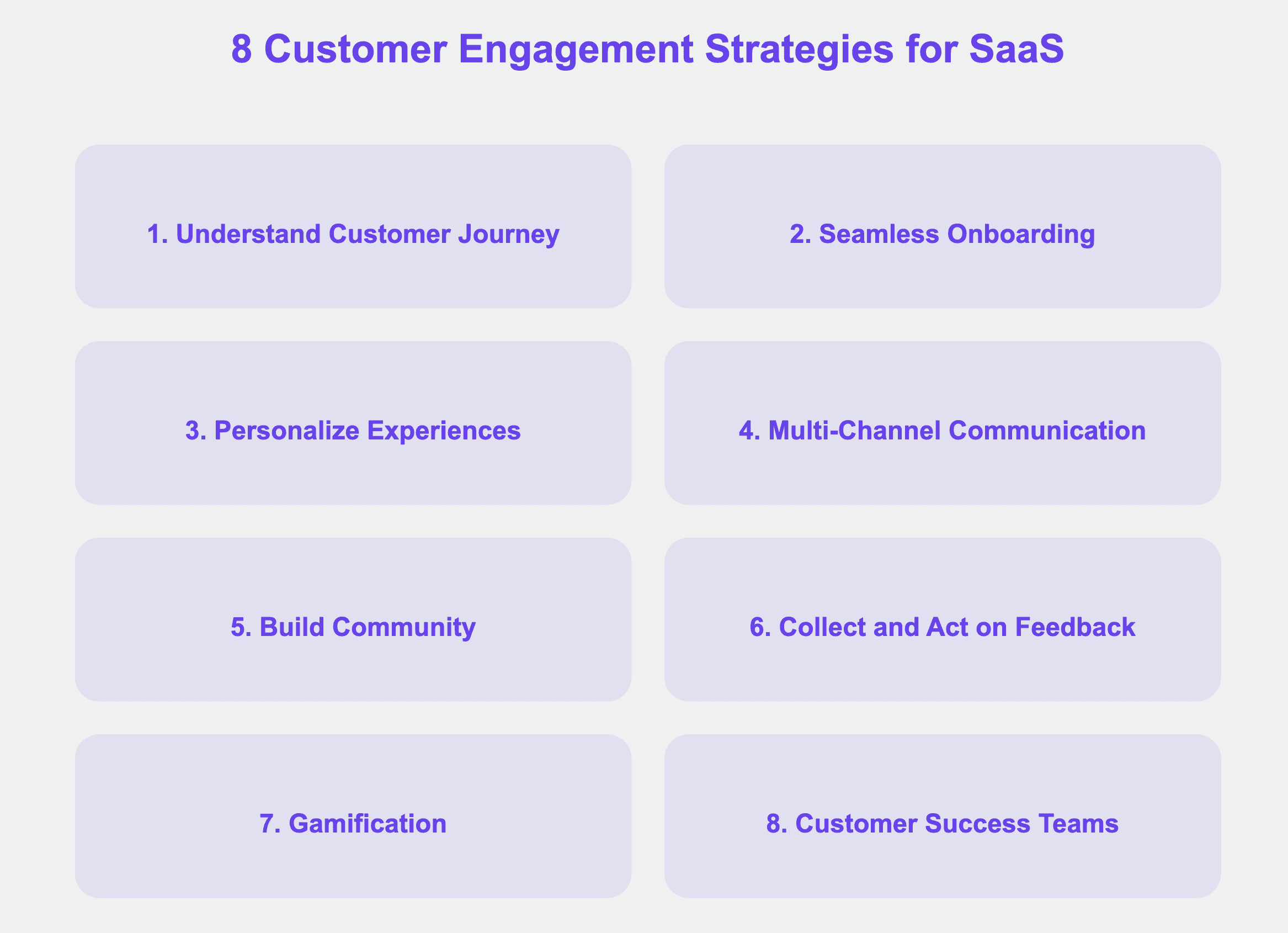
8 Customer Engagement SaaS Strategies + Real World Examples

by
Wiktoria Slowikowska
Oct 8, 2024
Identify and convert your most valuable users
Sign Up
Customer engagement is not just a priority; it’s the key to unlocking long-term success. SaaS businesses operate on subscription models, meaning retention rates, satisfaction, and recurring revenue are critical. Unlike traditional product sales, where the relationship ends at purchase, SaaS requires a continuous, meaningful relationship with customers to reduce churn and maximize customer lifetime value (LTV).

So, how do you build and maintain that engagement? Let’s explore some proven strategies that will help your SaaS business thrive. Along the way, we’ll look at real-world examples and insights from studies to back these approaches.

1. Understand the Customer Journey
To engage customers effectively, you first need to understand their journey. This involves mapping out every interaction a user has with your product, from discovery to long-term usage. Knowing these touchpoints enables you to deliver personalized experiences and targeted support at the right time.
Understanding user behavior is critical here. When you analyze how active users interact with your product, you can uncover valuable insights into what keeps them engaged and where they encounter friction. A well-defined customer journey gives you insights into what keeps users engaged and, more importantly, where they might drop off.
Example: HubSpot

HubSpot excels in this area by tailoring its engagement strategies to where users are in their lifecycle. New users receive onboarding help, while established users get more advanced resources and support. HubSpot’s strategic use of lifecycle stages helps them retain customers and keep them actively using their product.
McKinsey’s research found that companies that thoroughly map customer journeys see a 20% increase in customer satisfaction and a 15% rise in revenue. Understanding the journey ensures your customer relationship is built on trust and understanding.
Let’s move forward and see how onboarding plays a crucial role.
2. Create a Seamless Onboarding Process
A smooth and intuitive onboarding experience is essential for getting customers off to the right start. The goal is to show users how your SaaS product can help them solve their problems as quickly and efficiently as possible. Complex, drawn-out onboarding processes are one of the top reasons customers abandon SaaS products.
Onboarding is where many active users make their first real connection with your product. A report by Wyzowl found that 86% of users are more likely to stay loyal to a company that offers onboarding and education, while 63% of customers say they’ve stopped using a product due to a poor onboarding experience. A great onboarding process can improve user engagement and lead to higher engagement levels long-term.
Example: Slack

Slack’s onboarding process is a fantastic example of simplicity and effectiveness. When new users sign up, they are introduced to the basic functions, like creating channels and integrating apps, through a quick, step-by-step tour. This keeps users from feeling overwhelmed while showing them the value Slack can offer immediately.
By making the onboarding experience simple and results-focused, you can ensure that users reach their "aha" moment faster, where they recognize the core value of your product.
Let’s explore how personalization can amplify this engagement further.
3. Personalize User Experiences
In today’s competitive market, personalization is not optional—it’s an expectation. Customers want a tailored experience that resonates with their needs, preferences, and behaviors. Whether it’s through personalized emails, content recommendations, or product features, offering tailored experiences shows customers that you understand their unique needs.
Personalized experiences enhance customer experience and can increase customer loyalty. According to Accenture, 91% of consumers prefer brands that recognize and provide relevant recommendations. This kind of tailored engagement can significantly boost the likelihood of retaining customers and turning them into engaged customers.
Example: Spotify

Although not a traditional SaaS company, Spotify is a master of personalization. With features like "Discover Weekly" and "Daily Mix," Spotify curates playlists based on users’ listening habits, which keeps them coming back daily. SaaS companies can leverage similar strategies, using customer data to offer dynamic in-app content or personalized dashboards based on user behavior.
Let’s move on to another engagement pillar—consistent communication.
4. Maintain Consistent, Multi-Channel Communication
Engaging customers is not just about in-product interactions; it’s also about how you communicate with them across various touchpoints. Consistent communication via email, in-app notifications, live chat, and social media helps keep users informed, supported, and engaged over time.
According to Statista, email marketing boasts a 36:1 ROI, making it one of the most effective ways to maintain consistent communication and boost customer engagement metrics. Multi-channel communication also strengthens the overall customer experience, as users can choose the medium that works best for them.
Example: Intercom

Intercom uses a combination of personalized emails, in-app notifications, and live chat to keep customers updated and engaged. By being proactive across multiple channels, Intercom helps users stay informed about new features, troubleshoot problems quickly, and remain active users of the platform.
Consistent communication is just the beginning. Building a strong sense of community also plays a key role in engagement.
5. Build a Community Around Your Product
A thriving community can be one of the most powerful ways to engage customers. When users feel like they belong to a community, they’re more likely to stay loyal to your brand. Online forums, social media groups, webinars, and user meetups allow customers to interact not just with your team, but also with each other. This creates a sense of belonging and deepens the emotional connection to your product.
According to Salesforce, 80% of customers believe that the customer experience a company provides is just as important as its products. Building a strong community enhances that experience and fosters customer loyalty.
Example: Salesforce Trailblazer Community

Salesforce has perfected the art of community building with its “Trailblazer Community.” The platform allows users to ask questions, share insights, and network with other users globally. By facilitating these connections, Salesforce builds a loyal customer base that advocates for their brand and actively participates in its growth.
Up next, let’s talk about another way to keep customers engaged: acting on their feedback.
6. Actively Collect and Implement Customer Feedback
Collecting feedback from your users is crucial for understanding their needs, frustrations, and goals. But more importantly, you must act on that feedback. When customers see that their suggestions and concerns lead to real changes or improvements, it fosters trust and loyalty. Feedback loops show customers that you’re listening and care about their experience.
PwC reports that 59% of consumers will walk away from a brand after several bad experiences, and 17% will do so after just one. Acting on feedback helps you avoid these pitfalls while improving customer engagement metrics.
Example: Dropbox

Dropbox is known for listening to customer feedback and implementing key changes. When users expressed frustration over local storage limitations, Dropbox launched "Smart Sync," allowing files to be accessed without taking up hard drive space. This feature was directly influenced by customer feedback, showing how Dropbox values and responds to user input.
Now let’s look at another way to drive engagement: gamification.
7. Introduce Gamification to Encourage Engagement
Adding elements of gamification to your SaaS product can create a fun and motivating user experience. By introducing badges, progress bars, achievements, and rewards for completing certain tasks, you make your product more engaging and encourage users to explore and use more of its features.
Gamification taps into people’s natural desire for competition, achievement, and reward. According to Finances Online, 72% of people say that gamification motivates them to work harder and engage more. This strategy is highly effective in SaaS, where active users need continuous engagement.
Example: Duolingo

Duolingo uses gamification to engage users effectively. With daily streaks, badges, and leaderboards, Duolingo encourages learners to keep practicing and return to the app daily. By incorporating these fun, interactive elements, users feel more motivated to stay engaged and committed to their learning.
Finally, let’s wrap up with one more crucial strategy for engagement—customer success.
8. Use Customer Success Teams to Build Relationships
A dedicated customer success team is essential for building strong, lasting relationships with your users. Customer success managers (CSMs) help ensure that users are getting the most value out of your product, guiding them through challenges and helping them achieve their goals. This personalized attention makes users feel valued and understood.
A report by Gainsight found that companies using customer success strategies can reduce churn by up to 27%. This not only strengthens your customer relationship but also significantly improves engagement levels over time.
Example: Gainsight

Gainsight, a customer success platform, practices what they preach. They have a robust customer success team that checks in with users, offers training, and provides tailored advice based on user data. This approach helps Gainsight build deep relationships with its customers and ensures they get maximum value from the platform.
Final Thoughts
The SaaS business model thrives on user engagement. Without it, churn rates rise, and growth stalls. By implementing strategies such as personalized onboarding, consistent communication, community building, gamification, and customer success management, you can create an environment where your customers feel supported, heard, and valued.
These strategies will not only improve user retention but also turn your customers into advocates, driving word-of-mouth growth and long-term success. Now it’s time to start implementing these strategies and watch your customer engagement soar. Ready to take your SaaS engagement strategy to the next level?




